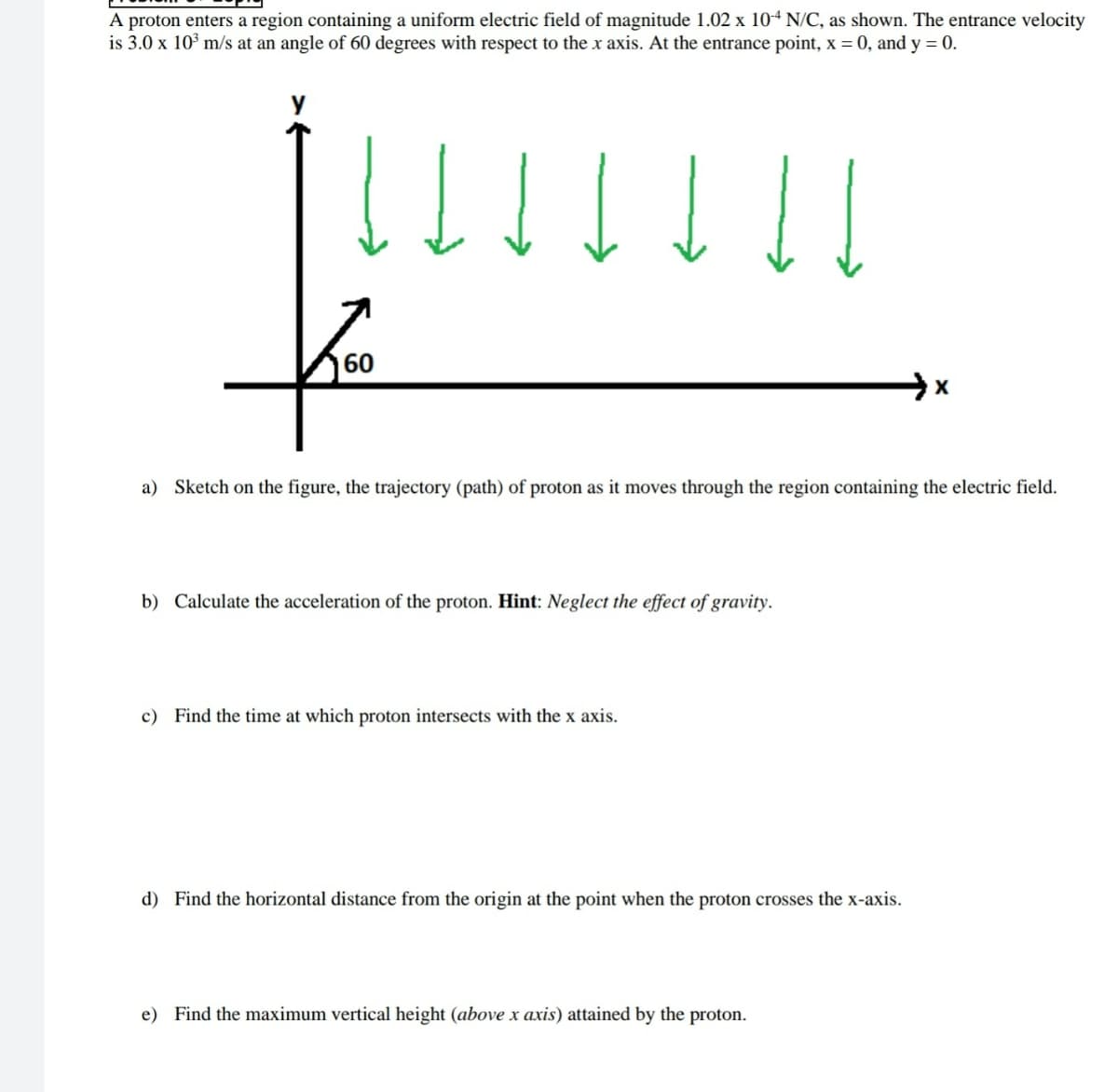A proton enters a region containing a uniform electric field of magnitude 1.02 x 104 N/C, as shown. The entrance velocity is 3.0 x 10° m/s at an angle of 60 degrees with respect to the x axis. At the entrance point, x = 0, and y = 0. y to 60 a) Sketch on the figure, the trajectory (path) of proton as it moves through the region containing the electric field. b) Calculate the acceleration of the proton. Hint: Neglect the effect of gravity. c) Find the time at which proton intersects with the x axis. d) Find the horizontal distance from the origin at the point when the proton crosses the x-axis. e) Find the maximum vertical height (above x axis) attained by the proton.
A proton enters a region containing a uniform electric field of magnitude 1.02 x 104 N/C, as shown. The entrance velocity is 3.0 x 10° m/s at an angle of 60 degrees with respect to the x axis. At the entrance point, x = 0, and y = 0. y to 60 a) Sketch on the figure, the trajectory (path) of proton as it moves through the region containing the electric field. b) Calculate the acceleration of the proton. Hint: Neglect the effect of gravity. c) Find the time at which proton intersects with the x axis. d) Find the horizontal distance from the origin at the point when the proton crosses the x-axis. e) Find the maximum vertical height (above x axis) attained by the proton.
Principles of Physics: A Calculus-Based Text
5th Edition
ISBN:9781133104261
Author:Raymond A. Serway, John W. Jewett
Publisher:Raymond A. Serway, John W. Jewett
Chapter19: Electric Forces And Electric Fields
Section: Chapter Questions
Problem 32P
Related questions
Question

Transcribed Image Text:A proton enters a region containing a uniform electric field of magnitude 1.02 x 104 N/C, as shown. The entrance velocity
is 3.0 x 10° m/s at an angle of 60 degrees with respect to the x axis. At the entrance point, x = 0, and y = 0.
y
to
60
a) Sketch on the figure, the trajectory (path) of proton as it moves through the region containing the electric field.
b) Calculate the acceleration of the proton. Hint: Neglect the effect of gravity.
c) Find the time at which proton intersects with the x axis.
d) Find the horizontal distance from the origin at the point when the proton crosses the x-axis.
e) Find the maximum vertical height (above x axis) attained by the proton.
Expert Solution
This question has been solved!
Explore an expertly crafted, step-by-step solution for a thorough understanding of key concepts.
Step by step
Solved in 2 steps with 2 images

Knowledge Booster
Learn more about
Need a deep-dive on the concept behind this application? Look no further. Learn more about this topic, physics and related others by exploring similar questions and additional content below.Recommended textbooks for you

Principles of Physics: A Calculus-Based Text
Physics
ISBN:
9781133104261
Author:
Raymond A. Serway, John W. Jewett
Publisher:
Cengage Learning

Physics for Scientists and Engineers: Foundations…
Physics
ISBN:
9781133939146
Author:
Katz, Debora M.
Publisher:
Cengage Learning

College Physics
Physics
ISBN:
9781285737027
Author:
Raymond A. Serway, Chris Vuille
Publisher:
Cengage Learning

Principles of Physics: A Calculus-Based Text
Physics
ISBN:
9781133104261
Author:
Raymond A. Serway, John W. Jewett
Publisher:
Cengage Learning

Physics for Scientists and Engineers: Foundations…
Physics
ISBN:
9781133939146
Author:
Katz, Debora M.
Publisher:
Cengage Learning

College Physics
Physics
ISBN:
9781285737027
Author:
Raymond A. Serway, Chris Vuille
Publisher:
Cengage Learning

Physics for Scientists and Engineers, Technology …
Physics
ISBN:
9781305116399
Author:
Raymond A. Serway, John W. Jewett
Publisher:
Cengage Learning

College Physics
Physics
ISBN:
9781938168000
Author:
Paul Peter Urone, Roger Hinrichs
Publisher:
OpenStax College

College Physics
Physics
ISBN:
9781305952300
Author:
Raymond A. Serway, Chris Vuille
Publisher:
Cengage Learning